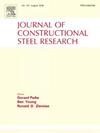Fire resistance of hybrid titanium-clad bimetallic steel plate girders under patch loading
IF 4
2区 工程技术
Q1 CONSTRUCTION & BUILDING TECHNOLOGY
引用次数: 0
Abstract
This study examined the mechanical properties of titanium-clad bimetallic steel (TCBS) and the resistance behavior of hybrid TCBS plate girders at high temperatures. The hybrid TCBS plate girder comprised a TCBS web and mild steel flanges and stiffeners. Initially, a steady-state test was performed to evaluate the mechanical properties of TCBS within 500 °C. The TCBS exhibited a ductile rupture mode at varying temperatures. After necking, the bonding interface showed different degrees of interlaminar separation. The mechanical properties progressively deteriorated with rising temperature. At 500 °C, the yield strength, ultimate strength, and elastic modulus decreased by 40 %, 50 %, and 26 %, respectively. The elongation after fracture initially reduced and subsequently increased with rising temperature. Additionally, the mechanical property retention factors of TCBS were compared with those of the substrate and cladding metals. Subsequently, a numerical approach was developed to evaluate the fire resistance of hybrid TCBS plate girders under patch loading. Parametric research involving 320 models was performed to elucidate the effects of geometric parameters, load length, and temperature. The degradation of material properties resulted in a substantial reduction in the ultimate capacity of hybrid TCBS plate girders. The ultimate resistance decreased by approximately 36 % at 500 °C. The applicability of the design method for steel plate girders at ambient in EN 1993-1-5 was evaluated. Based on EN 1993-1-5, a resistance reduction function applicable to hybrid TCBS plate girders at high temperatures was presented. The research findings establish a foundation for evaluating the resistance of hybrid TCBS plate girders in fire.
求助全文
约1分钟内获得全文
求助全文
来源期刊

Journal of Constructional Steel Research
工程技术-工程:土木
CiteScore
7.90
自引率
19.50%
发文量
550
审稿时长
46 days
期刊介绍:
The Journal of Constructional Steel Research provides an international forum for the presentation and discussion of the latest developments in structural steel research and their applications. It is aimed not only at researchers but also at those likely to be most affected by research results, i.e. designers and fabricators. Original papers of a high standard dealing with all aspects of steel research including theoretical and experimental research on elements, assemblages, connection and material properties are considered for publication.
 求助内容:
求助内容: 应助结果提醒方式:
应助结果提醒方式:


